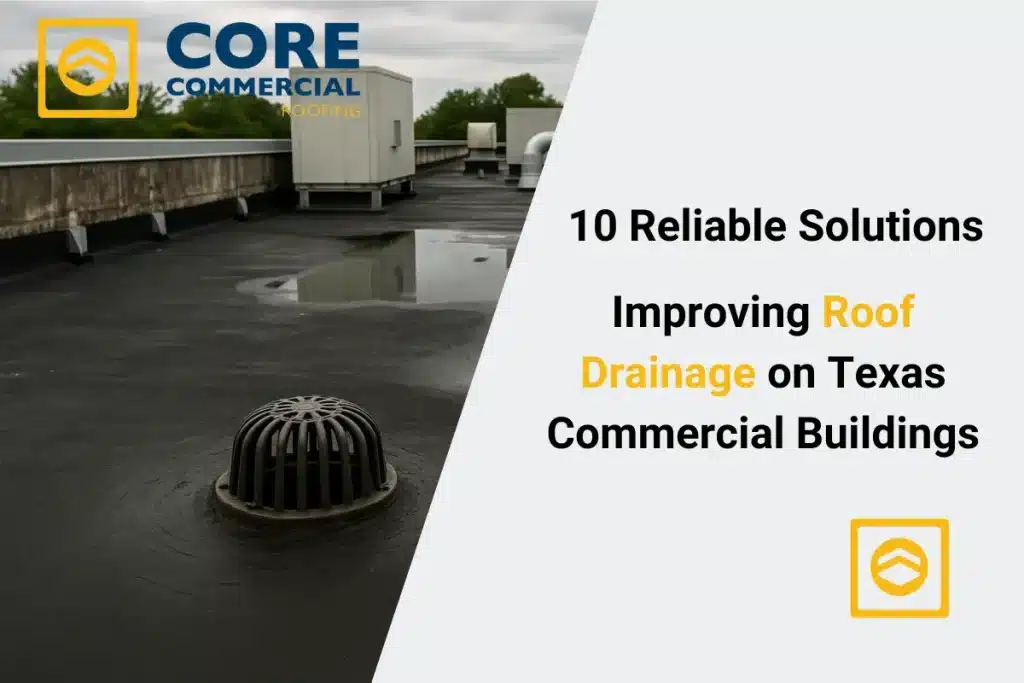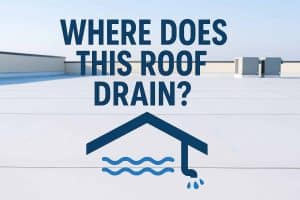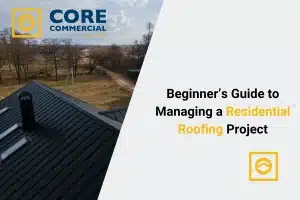In Texas, heavy rainfall, hailstorms, and sudden downpours aren’t just passing inconveniences—they’re major threats to commercial properties. Poor roof drainage can quickly turn a small maintenance issue into a financial nightmare: water pooling on your roof, leaks inside the building, structural damage, or even dangerous mold growth. The good news? You can avoid most of these problems with the right roof drainage. Improving Roof Drainage.

This guide breaks down 10 reliable and practical solutions specifically for Texas commercial buildings. Whether you’re managing a retail center in Houston, a warehouse in Dallas, or an office complex in San Antonio, these methods will help you safeguard your investment, prevent costly repairs, and ensure your building stays dry and structurally sound all year round.
Table of Contents
We’ll keep the language easy to understand, avoid industry jargon, and focus on real-world solutions that work, not sales talk. Let’s dive into smarter, cleaner, and more effective drainage for your building.
1. Inspect and Clean Roof Drains Regularly
Why it matters:
Clogged drains are the number one cause of ponding water on commercial roofs. Leaves, dirt, roofing debris, and even bird nests can block the flow of water, especially during storm season.
Texas-specific tip:
In places like Austin or Fort Worth, where oak and cedar trees are common, leaf buildup is fast. A simple cleaning schedule every 3 to 6 months—especially in the spring and fall—can prevent 90% of drainage problems.
User benefit:
Avoids standing water, leaks, and roof membrane breakdown. Saves you thousands on repairs and helps your roof last longer.
2. Install Larger or Additional Roof Drains
Why it matters:
Some older Texas buildings just don’t have enough drains for the size of their roof. Or the drains are too small to handle modern rainfall intensity.
Solution:
Work with a roofing contractor or engineer to calculate the right number and size of drains for your square footage and local rainfall data.
User benefit:
Faster water removal prevents pooling, extends roof lifespan, and reduces stress on your roof structure. It’s a one-time upgrade that pays off year after year.
3. Slope the Roof Surface Properly
Why it matters:
Flat roofs aren’t truly flat, but if the slope isn’t enough, water will linger and eventually find a way in.
In Texas:
Sun exposure causes roof materials to expand and contract, leading to subtle sagging over time. That’s especially true in hot, dry climates like El Paso or Lubbock.
Solution:
Use tapered insulation or re-pitch sections of the roof to direct water toward drains and scuppers.
User benefit:
Stops water from sitting in low spots, which prevents leaks, mold growth, and early roof failure.
4. Add Overflow Scuppers and Emergency Drains
Why it matters:
In a heavy storm, your primary drainage system might get overwhelmed. Without a backup, water can back up dangerously and even collapse the roof.
Texas code tip:
Commercial buildings are required to have emergency overflow drainage in most jurisdictions.
User benefit:
Gives you peace of mind during hurricane season or flash floods—your roof won’t become a swimming pool.
5. Upgrade to Weather-Resistant Gutter Systems
Why it matters:
Texas weather is harsh. High winds, hail, and UV rays can wear down low-quality gutters fast.
Solution:
Invest in commercial-grade aluminum or steel gutters that are resistant to rust, warping, and impact damage. Seamless systems reduce leaks.
Bonus tip:
Add leaf guards if your building is near trees.
User benefit:
Reliable, long-lasting water removal that holds up to Texas storms—less maintenance, fewer repairs.
6. Integrate a Roof Drainage Maintenance Plan
Why it matters:
One-time fixes don’t work forever. Without a system in place, problems creep back in over time.
Easy step:
Create a checklist with quarterly inspections, cleanings, and minor repairs. Assign a staff member or hire a local roof maintenance service.
User benefit:
Keeps your drainage performing at its best and prevents small issues from becoming emergencies. You’ll always be ready for the next storm.
7. Use High-Capacity Downspouts and Splash Blocks
Why it matters:
Water requires a complete path from the roof to the ground. If your downspouts are too small—or just dump water at the base—you’re risking foundation damage.
Upgrade idea:
Choose oversized downspouts with diverters and splash blocks that guide water safely away from your building’s perimeter.
Texas note:
In areas with clay-heavy soil, such as Houston, water near the foundation can cause significant shifting or cracking.
User benefit:
Protects your building’s foundation and landscaping. A must for long-term structural health.
8. Seal and Reinforce Drain Flashings
Why it matters:
The area where drains connect to the roof is a common weak spot. If that seal fails, water doesn’t go into the pipe—it goes into your insulation.
Fix:
Have a roofing pro inspect all drain flashings and re-seal or reinforce them as needed.
User benefit:
Stops hidden leaks that lead to mold, ceiling damage, and energy loss. A small investment that prevents major interior problems.
9. Install Smart Roof Monitoring Sensors
Why it matters:
Not all drainage problems are visible. Some water intrusion can go unnoticed until it causes interior damage.
Modern solution:
Install moisture sensors, water level alarms, or smart roofing monitors that alert you to problems in real time.
Great for Texas:
Protects against sudden weather shifts and rapid rainfall. Perfect for large warehouses or hard-to-reach roofs.
User benefit:
24/7 protection without needing constant inspections. Catches small issues before they become disasters.
10. Work with a Local Roof Drainage Expert
Why it matters:
Every commercial roof is different. Age, materials, location, and slope all affect the best drainage approach.
What to look for:
Hire a Texas-based professional who understands regional weather, building codes, and material performance under Texas heat and storms.
Tip:
Avoid national chains unless they have strong local teams. You need someone who knows how to build for Texas, not just sell systems.
User benefit:
Custom solutions that work. Better results, fewer mistakes, and expert advice tailored to your building and budget.
Final Thoughts: Don’t Let Drainage Be Your Downfall
Roof drainage might not be the most exciting topic, but it’s one of the most important for building health, especially in a state like Texas, where the weather changes fast and storms hit hard.
Whether you’re dealing with flat roof ponding, gutter backups, or simply want to extend the life of your roof, the solutions above will put you in control. The key is to be proactive, consistent, and smart about upgrades.
By tackling your drainage system head-on, you’re not just avoiding water damage—you’re protecting your investment, lowering your maintenance costs, and giving your tenants or employees a safer, more reliable space.
If your roof has been “just getting by,” now’s the time to act. A dry, strong, and damage-free roof starts with smarter drainage.
FAQs
How to fix ponding water on flat commercial roofs in Texas?
Ponding water on flat roofs can cause leaks and damage. To fix this, ensure drains are clear of debris. If water still pools, consider adding more drains or using tapered insulation to create a slight slope, helping water flow off the roof. Regular maintenance is key to preventing ponding.
Best drainage systems for Texas commercial flat roofs?
The best drainage systems for flat roofs in Texas include internal drains, scuppers, and gutters. Internal drains are placed in low spots to collect water. Scuppers are openings on the roof edge that let water drain off. Gutters collect water from the roof and direct it away from the building. Choosing the right system depends on your roof’s design and local weather patterns.
How often should commercial roof drains be cleaned in Texas?
In Texas, it’s recommended to clean commercial roof drains at least twice a year, ideally before and after the rainy season. However, if your building is near trees or experiences frequent storms, more frequent cleaning may be necessary to prevent clogs and water buildup.
What causes roof leaks in Texas commercial buildings?
Roof leaks in Texas commercial buildings can be caused by clogged drains, poor drainage design, damaged roofing materials, or extreme weather conditions like heavy rain and hail. Regular inspections and maintenance help identify and fix issues before they lead to leaks.
How to improve drainage on low-slope commercial roofs in Texas?
To improve drainage on low-slope roofs, ensure the roof has a slight pitch to direct water to drains. Use tapered insulation to create slopes where needed. Keep drains and gutters clear of debris. Installing additional drains or scuppers can also help manage water flow effectively.
Signs of poor roof drainage on Texas commercial buildings?
Signs include standing water on the roof 48 hours after rain, water stains on ceilings, mold growth, sagging roof areas, and frequent leaks. These indicate drainage issues that need immediate attention to prevent structural damage.
Importance of regular roof drainage maintenance in Texas?
Regular maintenance ensures that drains and gutters are free from debris, preventing water buildup that can lead to leaks and structural damage. In Texas, where the weather can be unpredictable, routine checks help extend the roof’s lifespan and maintain building safety.
How to prevent water pooling on commercial roofs in Texas?
Prevent water pooling by ensuring proper roof slope, keeping drains and gutters clean, and installing additional drainage points if necessary. Regular inspections, especially after storms, help identify and address potential issues early.
Cost-effective drainage solutions for Texas commercial roofs?
Installing tapered insulation to improve roof slope, adding scuppers or additional drains, and regular maintenance are cost-effective ways to enhance drainage. These solutions help prevent costly repairs by addressing water issues proactively.
Who to contact for commercial roof drainage issues in Texas?
For drainage issues, contact local roofing professionals experienced with Texas climates. They can assess your roof, recommend solutions, and perform necessary repairs or installations to ensure proper drainage and protect your building.






